Corpus Juris Civilis › The Parthenon Sculptures » Origins and History
Articles and Definitions › Contents
- Corpus Juris Civilis › Ancient History
- The Parthenon Sculptures › Antique Origins
Ancient civilizations › Historical places, and their characters
Corpus Juris Civilis › Ancient History
Definition and Origins
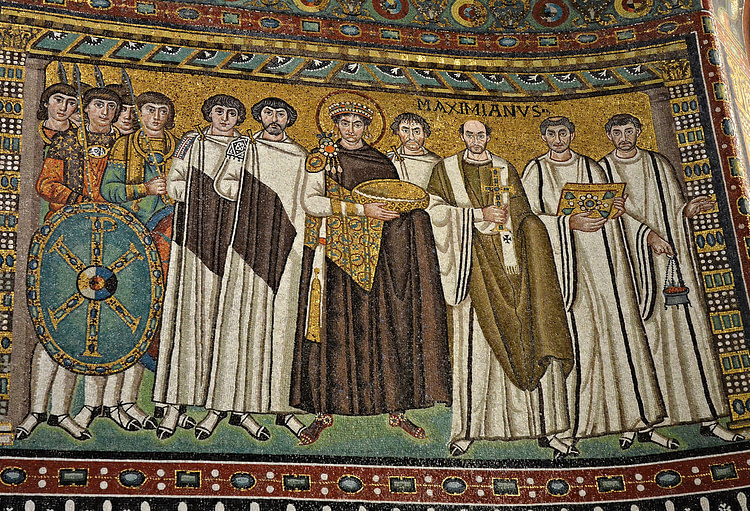
The Justinian Code or Corpus Juris Civilis (Corpus of Civil Law) was a major reform of Byzantine law created by Emperor Justinian I (r. 527-565 CE) in 528-9 CE. Aiming to clarify and update the old Roman laws, eradicate inconsistencies and speed up legal processes, the collection of imperial edicts and expert opinions covered all manner of topics from punishments for specific crimes to marriage and the inheritance of property. Not only used as a basis for Byzantine law for over 900 years, the laws therein continue to influence many western legal systems to this day.
A NEW LAW CODE
In February 528 CE Justinian I assembled a group of ten legal experts and 39 scribes to reassess Byzantine law and compile a new collective legislative code. It was a truly Herculean task which involved studying hundreds of documents and Latin Roman laws dating back to the early Roman Republic of the west, deciding which were no longer relevant, which should be maintained, and which needed some adapting. The old system relied on such diverse traditional sources of Byzantine law as the Codex Gregorianus (imperial edicts from 196 to 284 CE), Codex Hermogenianus (mostly imperial edicts of Diocletian, r. 284-305 CE), and Codex Theodosianus (issued in 438 CE and containing edicts dating back to Constantine I, r. 306-337 CE).
FROM OVER 2000 BOOKS & THREE MILLION LINES OF LEGAL TEXT, A NEW COMPREHENSIVE & CONSISTENT BODY OF LAWS WAS PRODUCED.
Many of the laws within the older works were repetitive, contradictory or simply did not meet the requirements of a society which had since moved on from earlier Roman times. From over 2000 books and three million lines of legal text, a new comprehensive and consistent body of laws had to be thrashed out and distilled and then better organised into subjects and themes. As a result, Justinian would achieve his multiple aims of making the laws clearer for all, reducing the number of cases brought before the courts (many were based on misunderstandings and a misinterpretation of what actually was the law), and increasing the speed with which legal cases were dealt with. Justinian may also have been motivated by a desire to outdo the famed legal achievements of Theodosius II (r. 402-450 CE), and this he undoubtedly did achieve. Finally, a new and consistent law code would help in Justinian's plan to expand the Byzantine Empire into new territories and bring those societies under the jurisdiction of Roman law.
CONTENT
The commission to update Byzantine law was led by the great legal expert Tribonian who had already served as quaestor of the Great Palace of Constantinople, the highest legal position in the empire. The first part of the Corpus Juris Civilis was completed in April 529 CE, and two more parts were added in the following year. The work superseded all previous legal documents and records of any kind. To add to these, Justinian himself issued decrees, and thus the Justinian Code was eventually made up of four main parts:
- Codex Justinianus - the Codex, issued in 529 CE, was a collection of 12 books containing 4,562 imperial edicts from the time of Hadrian (r. 117-138 CE) to Justinian I himself, organised by theme and all correctly attributed to the emperor who had made them and with a date. Interestingly, the first book deals with ecclesiastical topics whereas in the older codexes this was dealt with last - an indicator of how Christianityhad become more entrenched in Byzantine culture by the 6th century CE.
- Digestum (or Pandectae ) - the Digest (or Pandects), issued in December 533 CE, was a compendium of legal opinions by celebrated Roman jurists of the past, which could be cited by claimants and defenders in court. It was also designed to be of use to practising judges. These words of wisdom were all edited, reduced and assembled into 50 books (instead of the previous 1,500) and all organised by subject. The works of the prolific 2nd-3rd century CE lawyer and writer Ulpian (aka Domitius Ulpianus) were especially popular with Justinian's legal team, and these make up 40% of the Digest.
- Institutiones - the Institutes, also issued in December 533 CE, was a sort of handbook of the Codex and Digestum for law students to better understand and apply them. It was compiled by Trebonian and two other experts, Theophilos and Dorotheos.
- Novellae Constitutiones - the Novels (or New Laws) was a collection of the imperial edicts made by Justinian between 534 and 565 CE, the final year of his reign. Instead of Latin, as used previously (and still used in the other three parts), Greek was mostly used in these new edicts, the common language of the Byzantine Empire.
The laws within this huge body of work (still around 1 million words) dealt with every aspect of life and society in Byzantium.There are matters regarding the constitution, the powers of the emperor, the duties of high-ranking officials, and the sources of law. There are matters of private law and criminal law with punishments listed for specific crimes, as well as coverage of administrative affairs and issues related to tax, local government, the civil service, and the military. As with previous Roman law, a particular concern was the relations between individuals such as contracts, marriage, divorce, property ownership, inheritance, and succession. Finally, ecclesiastical matters were given much greater prominence in a departure from previous law codes.
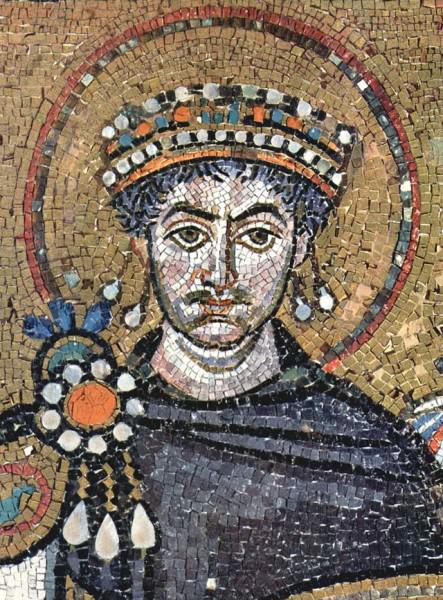
Justinian I
The Novels, in particular, addressed the social changes that Byzantine society had undergone and its evolution away from the Roman society of Constantine ’s days. Thus the rights of such groups as women, slaves, and children were improved.Further, it was now established, for the first time in Roman law, that the emperor was the single legitimate source of law.
Justinian's Code was itself revised within a few years to reflect recent legislation and reissued in December 534 CE (it is this version which exists today). To prevent any future confusion as to what was what, all commentaries on the Code were banned.The Code was studied by students of law in the fifth year of their studies. As a consequence, gradually most of the Codex was translated into Greek by the end of the 6th century CE. Justinian's Code was also introduced into the recently reconquered Italy (in 554 CE), but it was relatively neglected there until the 11th century CE when it was incorporated into the medieval Corpus Iuris Civils using Latin instead of Greek. Parts of North Africa also used the Code until the Arab expansion of the 7th century CE.
ROMAN & THEN BYZANTINE LAWS WERE, ABOVE ALL, RATIONAL, PRECISE & COMPREHENSIVE.
LEGACY
The body of laws created by Justinian and his experts, in one form or another, lasted for almost a millennium until the fall of the Byzantine Empire in 1453 CE. New Byzantine laws were, of course, added to it over the centuries as each emperor issued their own edicts and society evolved. Leo VI (r. 886-912 CE), for example, famously produced another collection of Byzantine edicts and had everything translated into Greek as next to nobody understood Latin anymore (few ordinary people would have even in Justinian's day).
The Corpus Juris Civilis may have failed in Justinian's aim to aid his imperial ambitions but, as it became a fundamental element of any higher education across Europe from the 11th century CE and has become the basis for many legal systems ever since, perhaps he did, in the end, achieve something of a lasting cultural domination. The Code is a monument to rival his other great achievement, the Hagia Sophia of Constantinople. Roman and then Byzantine laws were, above all, rational, precise and comprehensive, and it is these qualities which have greatly influenced many of the national and international laws by which we live today. As the historian JH Rosser notes:
The Corpus Juris Civilis not only preserved Roman law but provided the basis of law for emerging European nations. Its influence on western civilization is probably greater than any other book, except, of course, the Bible. (101)
The Parthenon Sculptures › Antique Origins
Ancient Civilizations
The extraordinary quality and quantity of the marble sculpture which adorned the 5th century BCE Parthenon in Athens made it the most richly decorated of all Greek temples. The sculpture, now mostly separated into the Parthenon Marbles (Elgin Marbles) and the Acropolis Museum Collection of Athens, once consisted of 92 metopes, a unique frieze running around all four sides of the building, and both pediments filled with 50 monumental figures. The sculpture presented scenes from mythology which were a metaphor for the Greek triumph over Darius and Xerxes in the recent Persian Wars. The whole edifice and fine artwork were designed to wow onlookers and glorify Athens and her patron goddess Athena. As the instigator of the whole project, Pericles rightly boasted "...we shall be the marvel of the present day and of ages yet to come".

Dionysos from the Parthenon.
THE PARTHENON
Built between 447 and 432 BCE, the Parthenon was dedicated to Athena, the patron deity of Athens, and contained a huge twelve metre high cult statue of the goddess made of wood, ivory, and a whopping 1,140 kilos of gold. Constructed in the golden age of Pericles, the massive temple measures around 31 x 70 metres and was a celebration of the Greek triumph over the invading armies of Persia. It was designed by the architects Iktinos and Kallikratis to proclaim to the world the glory of Athens, and for this reason its exterior was embellished with some of the finest architectural sculpture ever to be produced in antiquity.
Pentelic marble, 22,000 tons of it, was taken from nearby Mt. Pentelicus and used in the construction, as it was appreciated for its pure white appearance and fine grain. Traces of iron in the marble have, over time, given the stone a soft honey colour which is particularly evident at sunrise and sunset.
NEVER BEFORE HAD A GREEK TEMPLE BEEN SO RICHLY DECORATED.
The decorative sculpture was supervised by the master sculptor Pheidias, who was also responsible for the giant statue of Athena which stood inside the temple. That different sculptors worked on different pieces is evidenced by the varying quality of the sculpting and the sheer volume of work required. This was also, no doubt, a necessity due to the short time-frame for the construction. Never before had a Greek temple been so richly decorated. The main theme of the sculpture was the fight between order and chaos, a metaphor for the wars between Greeks and the Persian enemy they considered "barbarians".Much of the sculpture has suffered damage of various sorts over the centuries, but with the aid of descriptions by Pausanius of the 2nd century CE and drawings made by a Flemish artist (perhaps Jacques Carrey) in 1674 CE, some of the more seriously damaged pieces may be tentatively identified.

West Pediment of the Parthenon (Reconstruction)
THE PEDIMENTS
Pediments present the sculptor with the challenge of filling a triangular space, and in this case a large one of 28.55 metres long with a maximum height of 3.45 metre in the centre. Fifty outstandingly rendered figures decorated the pediments (but only eleven survive). These were sculpted in the round despite the fact that the back would not be seen from ground level, 16 metres below. In addition, the ends of the pediments had a lion-head sima or gutter (in this case false), one of which, from the north-east corner, survives.
To solve the problem of diminishing space in the corners, the sculptors had figures reclining near the ends or dissolving into an imaginary sea or even had the sculpture overhang the lower edge of the pediment. The east pediment depicted the birth of Athena (which connects nicely with the frieze's depiction of the Panathenaic Festival held on the goddess' birthday), whilst the west pediment showed the competition between Athena and Poseidon to become the patron of Athens, the former offering the Athenians a salty spring, the latter the first olive tree. This was another unusual feature - to have the deity of the temple appear on both pediments.
The west pediment was dominated by the two gods Athena and Poseidon (each three metres tall) arguing over who should win the favour of the Athenians. What stood between them survives only in fragments but may have been either Zeus ' thunderbolt or Athena's winning gift of the olive tree, possibly in bronze. Either side was a chariot with rearing horses, that closest to Poseidon probably carries his attendant Amphitrite, while on the left Athena's chariot is driven by Nike. Athena is also attended by Hermes, while Iris stands close to Poseidon. Then extending to the edges are various standing or seated figures, probably early Attic kings and heroes; the most certainly identified is Kekrops, portrayed with his conventional snake coils. Another easily identified figure is a sea monster representing the power of Poseidon to control the seas. The reclining figure on the far left side, whose leg disappears into the base of the pediment, has been identified as the river god Ilissos or Eridanos.
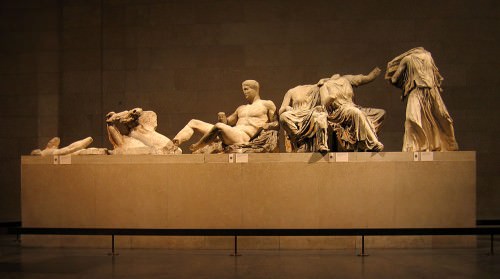
East Pediment of the Parthenon
The central composition of the east pediment is more speculative due to the paucity of the surviving pieces and the loss of the bronze identifying attributes the figures would have held in their hands. Zeus is centre-stage with his daughter Athena, just born, standing immediately to the right fully armed. Next to Athena stands Hephaistos who assisted in the birth by splitting open Zeus' head with his axe. The other Olympian gods make up the rest of the pediment sculpture. Helios and the horses of his chariot spring from the left corner which represents the ocean Okeanos, which encircled the world. Next is Dionysosreclining on his panther skin (the best preserved figure but possibly also identified as Hercules on a lion-skin, even if his early presence would be incongruous at the birth of Athena), next could be Demeter and Kore (or Persephone ) sitting on wooden chests, then Artemis (or Hebe) who seems about to step out of the pediment as she leans forward. Hera and Apollo may have stood to the left of Zeus. On the right side, after Poseidon's chariot, are probably Hestia, Dione, and Aphrodite who reclines on her mother's lap and may be identified by her robe seductively leaving one shoulder bare. In the far right corner may have been Selene (the Moon) or Nyx (Night) with the horse heads of her chariot team filling the right corner, mirroring those of Helios on the opposite side. The horses of Helios, though, are depicted full of energy as they begin their daily journey across the sky, while Selene's horses look exhausted, as they are at the end of their daily run and sink back into Okeanos.This signifies that the whole scene must be at dawn.

Centaur & Lapith Metope, Parthenon
THE METOPES
The Parthenon is again exceptional in that all the metopes were filled. The 92 metopes were carved in high relief (up to 25 cm in depth and almost in the round), and each slab measures around 1.25 x 1.2 metres. Thirty-two metopes, alternating with triglyphs, were placed along the long sides of the building, while each façade had 14. All the backgrounds were originally painted red.
The most important metopes were on the east side, as this was the principal entrance to the temple. Here the Olympian gods fight giants for control of the universe; four scenes show chariots but some of the gods remain unidentified due to their damaged condition. The west metopes depict Greeks fighting Amazons, the latter being another metaphor for foreigners and, as such, they wear oriental hats and costume. The figures are so badly damaged that it is impossible to be certain the figures are female, but the alternative, that they are Persian soldiers, seems unlikely given the mythological subjects of the rest of the sculpture on the Parthenon. The Greeks are semi-nude, and probably the hero Theseus is included in the narrative while the Amazons ride horses or fight on foot. Each metope portrays a one-on-one duel with sometimes the Amazons winning, sometimes the Greeks.
The north metopes show the fall of Troy - once again taken as a metaphor for Persia, an established convention in Attic art - with the first three (from the western end) showing deities seemingly in judgement of the proceedings, including Athena descending from her chariot. Other scenes include warriors leaving their ship, Odysseus searching for Helen, Menelaos meeting Helen, and the escape of Aeneas. The south metopes depict Greeks fighting centaurs, another metaphor for chaos and barbarism, possibly at the wedding of Perithous, the king of the Lapiths, when the centaurs became drunk and attempted to abduct the Lapith women. Theseus, the king of Athens, was one of the guests at the wedding, hence the connection with the city. They would have originally had bronze additions such as weapons; nevertheless, these metopes, nearer the steep sides of the acropolis, are amongst the best preserved of the Parthenon's sculptures, and they show a vibrant, dynamic struggle between the protagonists.
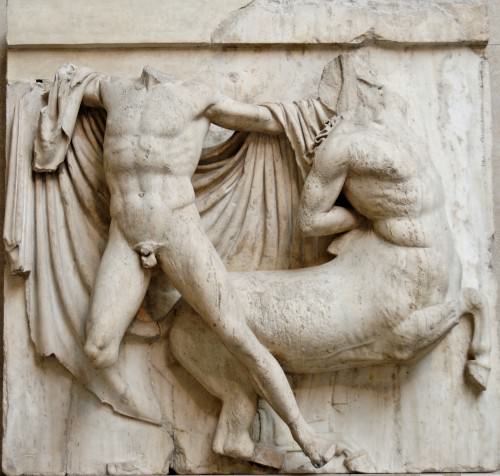
Lapith & Centaur, Parthenon Metope
THE FRIEZE
The frieze measures 160 metres in length, is almost one metre high, and includes an astonishing 380 figures and 220 animals, mostly horses, all carved in low relief (maximum 6 cm) overlapping across 115 slabs. Through a combination of surviving pieces and drawings, 90% of the frieze can be reconstructed. Running around all four sides of the building between the outer colonnade and the inner cella, the narrative of the frieze begins in the south-west corner and then runs parallel down the long sides to conclude at the far end, exactly over the main doorway. Such a design was an Ionic feature and more typical of treasury buildings. However, in reality the Parthenon and the gold sheeting on the statue of Athena also served as the city's treasury and that of the Delian League. The frieze was unusual in that it did not depict scenes from Greek mythology and unique because all four sides depict a single subject - the Panathenaic Procession. This was a religious ceremony held every four years which involved a procession along the Sacred Way and finally delivered a new, specially woven robe or peplos, the arrhephoros, to the ancient olive-wood cult statue of Athena housed in the Erechtheion next door to the Parthenon.
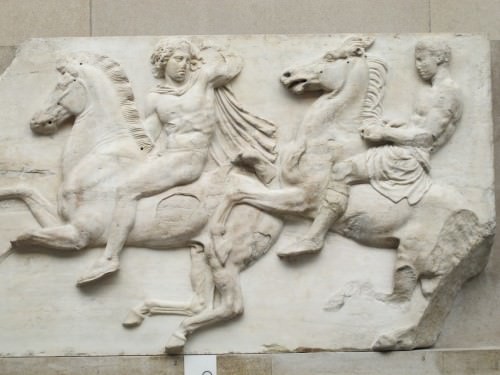
Horsemen from the Parthenon Frieze
As the space is narrow in which to view the frieze, the background of the scenes was painted blue, figures were also brightly painted in blue, red, and gold, and the relief made deeper at the top so that the figures seem to lean towards the viewer far below. Some details were painted rather than sculpted, three-dimensional additions such as weapons and horse reigns were added in bronze, and eyes were rendered using coloured glass.
A cavalcade fills 70% of the composition, and the actual robe ceremony seems to be depicted in the centre-east portion. There are dignitaries, musicians playing the kithara and aulos, and horsemen variously portrayed naked or wearing tunics or armour and perhaps representing the heroes of Marathon but also perhaps athletes riding for sport; some also see the mythical founder of the Panathenaic Festival Theseus as one of the riders. Other figures in the procession include marshals, elders or judges holding olive branches, charioteers ( apobates who jump on and off their moving chariots whilst wearing full hoplite armour as in the sporting event of the festival games), sacrificial animals (rams and oxen), women carrying water-pots, bowls and loom stands, boys carrying trays of offerings, heroes, and the Olympian gods who seem to be in animated conversation as they await the arrival of the procession.
Athena and Zeus take centre-stage, and they are both rendered slightly larger than the other gods in the frieze. The twelve gods are seated on stools with a throne reserved only for Zeus, and they are attended by two lesser deities. From the left side is Hermes with his famous hat on his lap, next is Dionysos who rests his arm on Hermes' shoulder, then comes Demeter who holds the torch which she used to search the underworld for her abducted daughter Persephone, then come Ares, Iris, and Hera, who is raising her bridal veil, then, finally, Zeus on his throne. To the right side is Athena with her aegis on her lap, then Hephaistos with the stick he carried for his lameness. Then sit Poseidon whose trident was added in paint, Apollo, who would have worn a gilded wreath as indicated by the small holes in his hair, Artemis, Aphrodite and, finally, Eros holding a parasol.

Panathenaic Procession
In the centre, on the east side, is the climactic scene of five figures engaged in the ceremony involving the peplos. There are three children, two of which are certainly girls. The adult male is perhaps the senior archon, who receives the peplos, and the woman may be the priestess of Athena, who takes a stool from one of the girls.
CONCLUSION
The Parthenon remained in use for over 1,000 years, but when it was converted into a Christian church in the 5th century CE, much of the decorative sculpture was deliberately damaged or removed in an effort to wipe away the pagan past. In addition, the inclusion of an apse on the east side required the removal of part of the east frieze. In 1458 CE the occupying Turks converted the building into a mosque, and in 1687 CE it was used as a powder magazine. This proved disastrous when a shell from the attacking Venetians set off the powder and ripped the heart out of the building. The Venetian general Morosini then did further damage when he tried to remove figures from the west pediment, smashing the horses when his rigging tackle collapsed. It seemed that the great art of this once great monument was destined to be lost forever.
Left as a glorious ruin with looters and souvenir hunters freely taking mementos from the site, in 1801 CE the Earl of Elgin obtained permission from the indifferent Turkish authorities for the right to take casts of the remaining sculpture and remove any pieces he fancied. This collection, known as the Elgin Marbles or Parthenon Marbles, was bought by the British government in 1816 CE, to be finally displayed in the British Museum, London. A portion of the frieze, a metope, and a head from a pediment figure also reside in the Louvre, Paris and several more pieces are scattered around European museums.Some of those pieces left on the monument were not removed until the 1980s and 1990s CE and have consequently suffered severe damage from air pollution; they are now displayed in the Acropolis Museum a few hundred metres from the Parthenon and arranged exactly in the sequence as they were originally with casts for the missing pieces. The debate goes on to unify the sculptures in a single exhibition space, but wherever they are to be seen, the Parthenon sculptures continue to enthrall the visitor and capture both the admiration and imagination of all, no doubt just as they did 2,500 years ago.
LICENSE:
Article based on information obtained from these sources:with permission from the Website Ancient History Encyclopedia
Content is available under License Creative Commons: Attribution-NonCommercial-ShareAlike 3.0 Unported. CC-BY-NC-SA License